| GISdevelopment.net ---> AARS ---> ACRS 1999 ---> Poster Session 4 |
Development of a personal
hybrid positioning system for high density urban areas
Yusuke Konishi, Ryosuke
Shibasaki and Masako Tsuruoka
Center for Spatial Information Science,Institute of Industrial Science,
University of Tokyo
4-6-1 Komaba,Meguroku,Tokyo 153-8505,Japan
Tel &Fax :(81)-3-5452-6417
E-Mail:konishi@skl.iis.u-tokyo.ac.jp
Center for Spatial Information Science,Institute of Industrial Science,
University of Tokyo
4-6-1 Komaba,Meguroku,Tokyo 153-8505,Japan
Tel &Fax :(81)-3-5452-6417
E-Mail:konishi@skl.iis.u-tokyo.ac.jp
Keywords: positioning system,personal
system,hybrid positioning,accelerometer,gyrometer
Abstract
Recently,many researches are being conducted on the personal or hand-held positioning technologies using GPS.However,GPS can ’ t work correctly at the location where the su . cient signal from the GPS satellites can not be received,for example,in the valley between buildings,underground shopping malls.It is strongly demanded to develop a complementary positioning system which can work in the areas where GPS is not available.In this paper,we report the progress of a personal hybrid positioning system which consists ofa pocket-size accelerometer, gyrocompass and a wearable PC.Through several basic experiments,it can be concluded that the positioning system has possibility ofproviding positional information with high accuracy as a complementary system ofGPS even in the areas where GPS signal is not available.
1 Introduction
To monitor and control the movement of goods and people,it is neccesary to obtain information about one ’ s position on the real time-basis.Recently,many researches are being conducted on the personal or hand- held positioning technologies using GPS.It is expected that these positioning technologies will be applied to managing and controlling logistics,securing safety of socially weak people,and so forth.
However,GPS accuracy and reliability is limited in the area where the su . cient signal from the GPS satellites can not be received, for example,in the valley between buildings, underground shopping malls.It is necessary to develop the positioning system which can complement GPS in ” high density ” urban areas.
In the case of car navigation,a complementary positioning system was already developed and reached practicable level.It is realized by counting number of wheel rotations,sensing steering angles,and matching positioning trajectory to map.On the other hand,there is no effective complementary positioning system for human under the present circumstances,although the development is strongly demanded.
In this paper,we report the progress of a personal hybrid positioning system which consists of a pocket-size accelerometer,gyrocompass and a wearable PC.
2 System
This system consists of a pocket-size accelerometer,gyrocompass (Japan Aviation Electronics,JIMS-30S )and a wearable PC(SII,Ruputer Pro ),as illustrated in Figure 1.
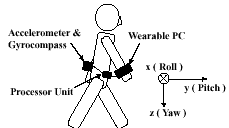
Figure 1: Personal Hybrid Positioning System
Both the pocket-size accelerometer and gyrocompass are in a cube whose side is about 3 centimeters,and the cube is fixed to the lower back of user.Signals from these sensors are transmitted through the cable and changed to physical values by the Processor Unit.The Processor Unit is fixed to the waist of user by waist pouch.The Processor Unit and the wearable PC like a wrist watch are also connected by the cable and, the wearable PC is used for computation and indication of the positional information.
3 Theory
Viewpoint of this paper is in the motion of walking human ’ s pelvis. At first,by using this positioning system, we measured the motion of pelvis when user walks 6 meters in 10 steps.The time-series data of rotation angles around each axes mesured by the gyrometer are illustrated in Figure 2. The axes are defined in Figure 1. And,we measured the motion of pelvis when user walks along a rectangular course.The time-series data of yaw angle is illustrated in Figure 3.
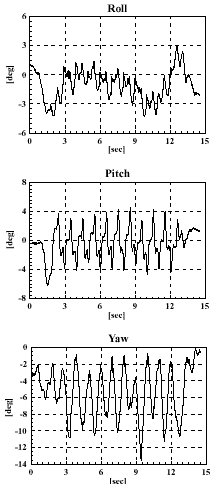
Figure 2: The motion of walking human ’ s pelvis measured by the gyrometer
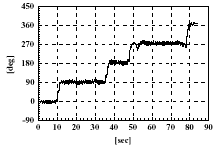
Figure 3: The time-series data of yaw angle when user walks along a rectangular course
The experimental data illustrated in Figure 2 and Figure 3 shows that number of steps is computed by the time-series data of pitch angle and direction of walking is computed by the time-series data of yaw angle.
Additionally,we measured the motion of pelvis when an identical user walks 14 meters in 22 steps,20 steps and 17 steps.The each time-series data of pitch angle are illustrated in Figure 4.
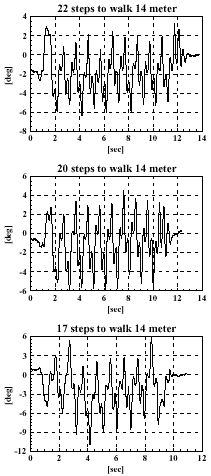
Figure 4: The time-series data of pitch angle whose forms change as number of steps
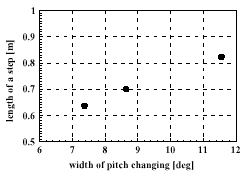
Figure 5: The relationship between width of changing pitch angle and length of a step
The relationship between width of changing pitch angle and length of a step which is computed by Figure 4 is illustrated in Figure 5.
The experimental data illustrated in Figure 5 shows that length of a step is computed by the time-series data of pitch angle.
Therefor important parameter of walking which includes number of steps,length of a step,and direction of walking,can be computed by using information about the motion of pelvis which is measured by the gyrometer.And then,the positional information can also be computed by the parameter about walking.
4 Experiment
To prove applicability of this system,we examined how accurately this system can compute the positioning trajectory.The experiment was made using the rectangular course whose longer side is 30 meters and shorter side is 15 meters.The positioning trajectory which computed by this system when user walked along the rectangular course is illustrated in Figure 6.
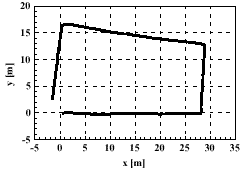
Figure 6: The positioning trajectory computed by this system when user walked along the rectangular course whose longer side is 30 meters and shorter side is 15 meters
The experimental data illustrated in Figure 6 shows that the positioning trajectory be computed very accurately in such a simple course.
5 Conclusions
Through several basicexperiments,it can be concluded that this positioning system has possibility of providing positional information with high accuracy in the case of walking.
The problem for this positioning system is that movement in the height direction and movement by ” non-walking ” methods like by car and train cannot be computed. For the purpose of this positioning system shows,it is very important to compute the movement using stairs,escalators,elevators, cars,trains and so on.Theoretically,it is expected that movement vector can be computed by integrating acceleration measured by the accelerometer,but it is con . rmed that this integrating isn ’ t practical,because accuracy of the accelerometer is very low for this purpose.
At first,development of an algorithm which can distinguish modes of action,like walking,running,going up or down stairs, standing,sitting,and so on,is necessary for this problem.And it is important to automatically identify the modes of movement (e.g.walking)which the personal positioning system can be applied to.On the other hand,it will be very di . cult to compute directly the positional information when user is going by elevators,buses,cars,trains and subways.Therefore,in this case,it is necessary to distinguish transportation mode (e.g.car,train)which a user is using,and to use additional information to determine the location.It is also very interesting that the other sensors like a microphone for speech recognition or a barometer for elevation estimation have possibility to give us more information about user ’ s action.
After discussing about these ideas and doing many experiments to prove the availability of this positioning system,we will complete this developement of the personal hycan brid positioning system.And then,we have to prove how accurately this positioning system can complement GPS.
References
Abstract
Recently,many researches are being conducted on the personal or hand-held positioning technologies using GPS.However,GPS can ’ t work correctly at the location where the su . cient signal from the GPS satellites can not be received,for example,in the valley between buildings,underground shopping malls.It is strongly demanded to develop a complementary positioning system which can work in the areas where GPS is not available.In this paper,we report the progress of a personal hybrid positioning system which consists ofa pocket-size accelerometer, gyrocompass and a wearable PC.Through several basic experiments,it can be concluded that the positioning system has possibility ofproviding positional information with high accuracy as a complementary system ofGPS even in the areas where GPS signal is not available.
1 Introduction
To monitor and control the movement of goods and people,it is neccesary to obtain information about one ’ s position on the real time-basis.Recently,many researches are being conducted on the personal or hand- held positioning technologies using GPS.It is expected that these positioning technologies will be applied to managing and controlling logistics,securing safety of socially weak people,and so forth.
However,GPS accuracy and reliability is limited in the area where the su . cient signal from the GPS satellites can not be received, for example,in the valley between buildings, underground shopping malls.It is necessary to develop the positioning system which can complement GPS in ” high density ” urban areas.
In the case of car navigation,a complementary positioning system was already developed and reached practicable level.It is realized by counting number of wheel rotations,sensing steering angles,and matching positioning trajectory to map.On the other hand,there is no effective complementary positioning system for human under the present circumstances,although the development is strongly demanded.
In this paper,we report the progress of a personal hybrid positioning system which consists of a pocket-size accelerometer,gyrocompass and a wearable PC.
2 System
This system consists of a pocket-size accelerometer,gyrocompass (Japan Aviation Electronics,JIMS-30S )and a wearable PC(SII,Ruputer Pro ),as illustrated in Figure 1.

Figure 1: Personal Hybrid Positioning System
Both the pocket-size accelerometer and gyrocompass are in a cube whose side is about 3 centimeters,and the cube is fixed to the lower back of user.Signals from these sensors are transmitted through the cable and changed to physical values by the Processor Unit.The Processor Unit is fixed to the waist of user by waist pouch.The Processor Unit and the wearable PC like a wrist watch are also connected by the cable and, the wearable PC is used for computation and indication of the positional information.
3 Theory
Viewpoint of this paper is in the motion of walking human ’ s pelvis. At first,by using this positioning system, we measured the motion of pelvis when user walks 6 meters in 10 steps.The time-series data of rotation angles around each axes mesured by the gyrometer are illustrated in Figure 2. The axes are defined in Figure 1. And,we measured the motion of pelvis when user walks along a rectangular course.The time-series data of yaw angle is illustrated in Figure 3.

Figure 2: The motion of walking human ’ s pelvis measured by the gyrometer

Figure 3: The time-series data of yaw angle when user walks along a rectangular course
The experimental data illustrated in Figure 2 and Figure 3 shows that number of steps is computed by the time-series data of pitch angle and direction of walking is computed by the time-series data of yaw angle.
Additionally,we measured the motion of pelvis when an identical user walks 14 meters in 22 steps,20 steps and 17 steps.The each time-series data of pitch angle are illustrated in Figure 4.

Figure 4: The time-series data of pitch angle whose forms change as number of steps

Figure 5: The relationship between width of changing pitch angle and length of a step
The relationship between width of changing pitch angle and length of a step which is computed by Figure 4 is illustrated in Figure 5.
The experimental data illustrated in Figure 5 shows that length of a step is computed by the time-series data of pitch angle.
Therefor important parameter of walking which includes number of steps,length of a step,and direction of walking,can be computed by using information about the motion of pelvis which is measured by the gyrometer.And then,the positional information can also be computed by the parameter about walking.
4 Experiment
To prove applicability of this system,we examined how accurately this system can compute the positioning trajectory.The experiment was made using the rectangular course whose longer side is 30 meters and shorter side is 15 meters.The positioning trajectory which computed by this system when user walked along the rectangular course is illustrated in Figure 6.

Figure 6: The positioning trajectory computed by this system when user walked along the rectangular course whose longer side is 30 meters and shorter side is 15 meters
The experimental data illustrated in Figure 6 shows that the positioning trajectory be computed very accurately in such a simple course.
5 Conclusions
Through several basicexperiments,it can be concluded that this positioning system has possibility of providing positional information with high accuracy in the case of walking.
The problem for this positioning system is that movement in the height direction and movement by ” non-walking ” methods like by car and train cannot be computed. For the purpose of this positioning system shows,it is very important to compute the movement using stairs,escalators,elevators, cars,trains and so on.Theoretically,it is expected that movement vector can be computed by integrating acceleration measured by the accelerometer,but it is con . rmed that this integrating isn ’ t practical,because accuracy of the accelerometer is very low for this purpose.
At first,development of an algorithm which can distinguish modes of action,like walking,running,going up or down stairs, standing,sitting,and so on,is necessary for this problem.And it is important to automatically identify the modes of movement (e.g.walking)which the personal positioning system can be applied to.On the other hand,it will be very di . cult to compute directly the positional information when user is going by elevators,buses,cars,trains and subways.Therefore,in this case,it is necessary to distinguish transportation mode (e.g.car,train)which a user is using,and to use additional information to determine the location.It is also very interesting that the other sensors like a microphone for speech recognition or a barometer for elevation estimation have possibility to give us more information about user ’ s action.
After discussing about these ideas and doing many experiments to prove the availability of this positioning system,we will complete this developement of the personal hycan brid positioning system.And then,we have to prove how accurately this positioning system can complement GPS.
References
- Hideo KAWAI,Haruyoshi IWAMOTO and Koji TORII,1988.A Route Navigational Composite System of Pedometer and Azimuth Compass for Human. T.IEICE,J71-A-11,pp.2054-2062.
- Takayuki TAKAHASHI,Hirofumi OSAWA,Akihiro SUZUKI and Hikaru INOOKA,1995.An Improved Algorithm and Implementation for the Ambulatory Measuring System of Human Gait. T.SICE,32-7,pp.1057-1064.
- Koichi SAGAWA,Atsushi INA, Takayuki TAKAHASHI,Tadashi ISHIHARA and Hikaru INOOKA,1998. Estimation of Human Moving Behavior by Using Acceleration and Air Pressure. T.SICE,35-2,pp.184-190.